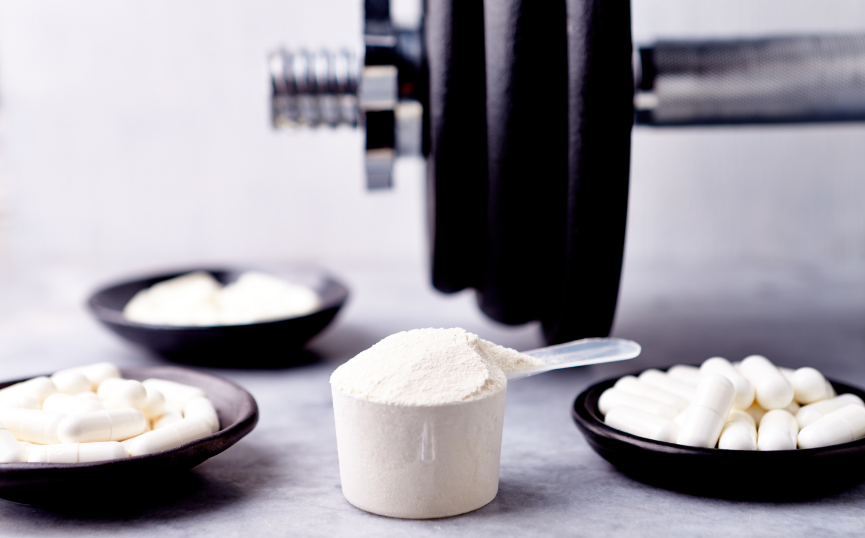All about creatine
Creatine is solid as a rock. It’s been on the shelves of gyms since the golden age of bodybuilding, but it was discovered before you’d think. First used by competitive athletes, creatine is now used by everyone. Everyone, in fact, from amateur adult athletes to teenager and older people trying to stay fit. It is normal for teenagers to be using (spoiler: not so much…)? It is really beneficial for the older body? These are among the questions we seek to answer in our comprehensive and all-encompassing article on creatine.

We also answer the key question: how much of that? Because in the golden age of bodybuilding, creatine monohydrate was the only thing known. Now you can get lost in the repertoire of creatine forms. Creatine is now available in several forms: tri-creatine malate; creatine citrate; creatine nitrate; creatine hydrochloride (hcl); creatine alkaline and creatine ethyl ester.
Creatine was first discovered in 18321, but in the early 1990s there was an explosion of research into its performance-enhancing effects.2 And nowadays, studies are also reporting on its health-promoting properties.3 Apart from creatine, there is hardly any other ergogenic (performance-enhancing) supplement whose effects are in almost consistent agreement in the literature.4 We'll look at these different features in more detail in a moment, but first, let's get the basics straight!
WHAT IS CREATINE?
Creatine is a high nitrogen organic acid with a structure similar to amino acids. Creatine is made by our body from amino acids called arginine, glycine and methionine, so that it can then be used as an energy source (95% of total creatine is made up of muscle fibres).
To make creatine work, we need to understand the concept of ATP. Adenosine triphosphate, or ATP, is its basic fuel. All caloric food is broken down into ATP. Did you read the "-tri" in it? That means it contains 3 phosphate groups. If you cut off one of these, you get ADP and 30 kJ of energy is released. And the creatine comes into play because phosphate as an element can only be stored as creatine phosphate. It is the cleavage of the phosphate group from the creatine phosphate that will regenerate the ADP (this is done by an enzyme called creatine kinase). Using the example of muscle fibres: the body's ATP store is only sufficient for a few muscle contractions (equivalent to a few seconds of exercise), after which the muscle cell will remove the phosphate from the creatine phosphate, thus gaining a few seconds before the Szentgyörgyi-Krebs cycle (i.e. aerobic energy production requiring oxygen) is triggered.
So creatine phosphate provides energy during the few seconds of intense exercise. So our body uses creatine: for sprints, strength and burst exercises.
Studies have confirmed that creatine can have a performance-enhancing effect in the following sports:
- You can increase maximum strength during strength training.5-7
- Cycling training8,9 - increases strength for sprints.
- Running training10,11 - increases strength for sprints.
- Ball games 12,13,16 - in addition to sprints, you can increase your kicking and throwing power, as well as your kicking and counter kicking power.
- Swimming14 - the effect is most noticeable in breaststroke and butterfly because these are the two swimming strokes that rely most on muscle strength.
- Dance15 - the use of creatine can be an advantage in dance styles that require athletic (explosive and fast-paced) movement; such as swing, breakdance, charlston, jive, etc.
- Combat sports17: one study looked specifically at the effects on judo competitors, but based on the former sports and the mechanism of creatine, it may be beneficial in all combat sports. This is because fighters rely on explosive power most of all.
- +1: Gymnastics, calisthenics, street workout, prisoner training: although studies have not investigated these types of training, creatine's known effects mean that it will be beneficial in short bursts of effort such as: bar holds and explosive exercises such as push-ups and pull-ups.
WHY IT IS SO POPULAR?
Creatine started to become dramatically popular after the 1992 Barcelona Olympics. Many sprinters and powerlifters testified that creatine consumption played a major role in their training. Since then, its popularity has continued unabated and the demand for various creatine products such as tri-creatine malate, creatine citrate, creatine nitrate, creatine alkaline and creatine ethyl ester has been growing.
The secret of creatine is that it is a natural substance that restores your body's internal balance. This means that once your body is saturated with it, it can’t use any more of it (i.e. it's excreted in the urine). More is not better than less creatine, but a lack of it can lead to poor performance. So creatine is the only performance enhancer that DOESN'T HAVE AN EXTRA ADVANTAGE, IN ADDITION TO ANABOLIC AMOUNTS AND COFFEEINE. While with caffeine we can adapt, i.e. we may need increasing amounts to achieve the same effect - and this can be a dangerous 'vicious circle' - this cannot happen with creatine. At higher doses, the degree of side effects (such as stomach upset and water retention) will increase. Of course, you need to know exactly what you can and cannot expect from creatine!

CREATINE EFFECTS – LET’S BE REALISTIC
Creatine is not a panacea, but with the right training programme it can be! It can not only increase performance, but also muscle mass at the same time. However, muscle strength does not equal muscle mass, because strength depends on how well your motor neurons (motor nerves) are able to work in coordination. Progressive overload (i.e. moving a little more or moving more intensely from session to session) is the main driver of muscle growth. Therefore, it follows that if we perform better in training, we will be more muscular. This has been confirmed by studies.29-32
Creatine may also have health-promoting effects. Creatine in moderation will make you healthy! Creatine can improve the course of all diseases that affect the energy-producing processes of cells. In general, these lesions become more severe with age.
Diseases that may benefit from creatine:
- Alzheimer's disease, dementia and Parkinson's disease: in all of these cases, creatine metabolism can be upset, so "in theory" creatine consumption can help the disease. It can improve mental performance (as brain cells also use creatine for energy), increase muscle strength and reduce general fatigue. 33-35,37-44 In truth, each of these areas suffers from a lack of large clinical studies.33
- Myasthenia gravis: this disease is autoimmune in origin and results in a disruption of the brain-muscle connection. A case study of a 26-year-old patient with myasthenia found that physical exercise and creatine consumption together can increase strength.36
- Huntington's disease: a genetic disorder usually affecting middle-aged people, associated with mood swings, abnormal gait, tremors and epileptic seizures.45-48 The ratio of creatine phosphate to free phosphate in patients' bodies is upset.49 This may justify the use of creatine in individuals with Huntington's disease. Confirming this, one study found that creatine can significantly prolong survival.50
- This may justify the use of creatine in individuals with Huntington's disease. Confirming this, one study found that creatine can significantly prolong survival.50
Overall, the studies are in agreement and promising, but too few to draw any conclusions. We would recommend Vitamin360 as a one-person approach to empowering parents/grandparents in decline. After medical consultation of course!
Other conditions where creatine can help:
- Depression: have you ever known a passive depressive who finds it difficult to get out of bed? This is (also!) because creatine metabolism is also upset in depression. Therefore, creatine supplementation can help manage depression.51-54
- Rehabilitation after brain injury: after traumatic nerve cell damage, ATP use becomes so high that it can destroy the part of the cell responsible for energy production: the mitochondria. Because of its ATP-preserving effects, creatine can stimulate the process of recovery from brain injury.55,56
- Cardiovascular health: the heart contains the most creatine kinase enzymes, so the heart has the highest creatine demand! Creatine is most needed in times of oxygen deprivation.57 In other words, creatine strengthens the heart muscle and can reduce damage during a stroke or heart attack.58 If the problem has occurred, it can help the healing process.59 It may also reduce levels of homocysteine and 'bad' cholesterol.60 Thus reducing the risk of atherosclerosis.
So creatine is healthy, maybe all adults should use it in the long term, in amounts of 2.5 - 5 grams (see: dosage)! Physical and mental stress affects everyone, and if it doesn't, it means sitting at home depressed. Creatine can also help with the latter. So start using it!
POSSIBLE SIDE EFFECTS OF CREATINE
The truth is that there are no clinically significant side effects. A single high dose of creatine can cause stomach upset.
In addition, muscle cramps can occur because creatine can bind water and cause dehydration (if creatine consumption is not combined with increasing water intake).20-22 In fact, 5-10 g of creatine monohydrate per day has been found to be safe in studies.23,24 Specifically 5g of creatine monohydrate has been found to be safe in the long term and 10 g per day has been used safely for nearly a year in older people.
The only certain „side effect” is water weight gain. 25,26 If you are preparing for a competition, photo shoot or summer and are new to creatine, it is recommended that you do not „load up” on creatine monohydrate, i.e. do not use a higher dose initially, but start with the maintenance dose of 5 grams, this will still fill your body with creatine, although it will take longer, but the amount of „water retention” can be drastically reduced. 27 An alternative to water retention is to use a creatine hydrochloride supplement instead of creatine monohydrate.
One more important thing to note! Creatine will be broken down in the body into creatinine after use. And creatinine is a biomarker in the blood that monitors kidney function. This means that elevated creatinine levels can indicate renal impairment. A daily creatine intake of 5 grams per day will not increase blood creatinine levels, but above this level, creatinine levels may increase, which will generate a false positive result in the blood count. This is because creatine intake does not damage the kidneys, but more creatine is broken down by more creatine intake.28
Creatine may interact with the following medicines74-76:
- Non-steroidal anti-inflammatory drugs
- Diuretics
- Cimetidine: a stomach acid medicine. Use with creatine may increase the risk of kidney damage.
- Probenecid: gout medicine
- Aminoglycoside antibiotics and other potentially kidney damaging substances.
Knowing this information: if you are taking any medication (or have any medical condition), it will be important to consult your doctor before using creatine!

TYPES OF CREATINE, WHICH IS GOOD FOR WHAT, WHICH IS THE BEST?
There are several creatine sub-forms available on the market, we will now take a closer look at which form can offer extra benefits.
1. The traditional creatine-monohydrate, spoiler: old school is always a winner!
Creatine monohydrate remains the most widely used and studied form of creatine today. The downside is that side effects can be higher at higher doses, but since the other forms are not as well studied, we would recommend creatine monohydrate as a general rule. However, there are other forms that may be more justified in certain cases. Let’s have a look at them!
2. Creatine-hydrochloride (Creatine-HCl): a water retention reducer.
Creatine hydrochloride had a better water solubility than creatine monohydrate, so it can be effective at lower doses. Furthermore, for athletes who need to keep their weight under close control, creatine hydrochloride may be more appropriate as it does not cause water retention to the same extent as creatine monohydrate.61
3. Creatine nitrate: also increases the feeling of pumpiness
Creatine nitrate is a combination of a creatine and nitrogen molecule. It’s extra advantage lies in the nitrate, because when broken down, it can have the effect of creatine as well as the blood-levelling property of nitrate. This is because nitrate is used by the body to produce NO (nitric oxide), which has vasodilating effects.62 It may also theoretically stimulate creatine utilisation by increasing blood volume.62
4. Creatine ethyl ester
Creatine ethyl ester is often touted as a better alternative to creatine monohydrate, with better absorption and fewer side effects. But this has not been supported by research.63-65
5. Creatine citrate
Creatine citrate, a form of creatine combined with citric acid, may already be a better alternative than ethyl ester. Two studied have compared it with creatine monohydrate. In one, the results were very similar, but the citrate was utilized somewhat more quickly.66 The other showed similar effects, but the side effects (upset stomach and water retention) were less pronounced with citrate compared to monohydrate.67 Overall, there is no difference in their effects between citrate and monohydrate. Minor side effects are less for citrate, but monohydrate is a much more studied form.
6. Buffered creatine (Kre-Alkalyn)
Buffered creatine is a pH-boosted form of creatine so that creatine is theoretically more tolerant of the stomach acid environment. This may improve the absorption of buffered creatine compared to creatine monohydrate, but studies have not found significant differences in utilization and efficacy.68,69
7. Tri-creatine malate: the most powerful formula.
A combination of creatine and malic acid. On the one hand, its acidity may increase its absorption, and malic acid plays a role in the Krebs cycle mentioned at the beginning of this article. Therefore, in theory, tri-creatine malate may have an effect not only on anaerobic work but also on aerobic energy production. It may thus have stronger performance-enhancing properties compared to creatine monohydrate. This has been confirmed by studies72, but its potency is not much superior to monohydrate.71,73 So tri-creatine malate can be stronger in practice!
Creatine forms: summary
Due to the relatively small numbers of studies, Vitamin360 would still recommend the traditional creatine monohydrate for general use.
If the sole purpose is to increase energy, tri-creatine malate may be a good (better) choice.
For extra blood volume (feeling pumped during workouts), choose creatine nitrate.
In racing season, creatine hydrochloride to keep you from gaining so much water.
And for health, creatine monohydrate, because it’s been used in a small number of clinical trials.
CREATINE POWDER OR CAPSULE?
For ease of administration and value for money, Vitamin360 would definitely choose powder. Otherwise, there is no extra absorption advantage to capsulated creatine.
CREATINE DOSAGE, WHEN, HOW?
For general health: 3-5 grams of creatine monohydrate. In the treatment of illness (with the permission of a specialist), you may require higher doses or replenishment phase.
Creatine monohydrate for replenishment: 15-25 grams per day for a week, then also 2.5-5 grams for maintenance.
Higher doses should be divided into 3 parts and taken with meals to reduce the risk of stomach upset.
AT WHAT AGE CREATINE CAN TAKEN?
Creatine is not recommended for use under the age of 18. It is not considered healthy and there has been a lot of research into its effects. It’s long term effects in children are not known, which is why the American Academy of Pediatrics and the American Society of Sports Medicine recommends it only for children over 18.17 So teenager, please wait before using it!

